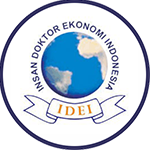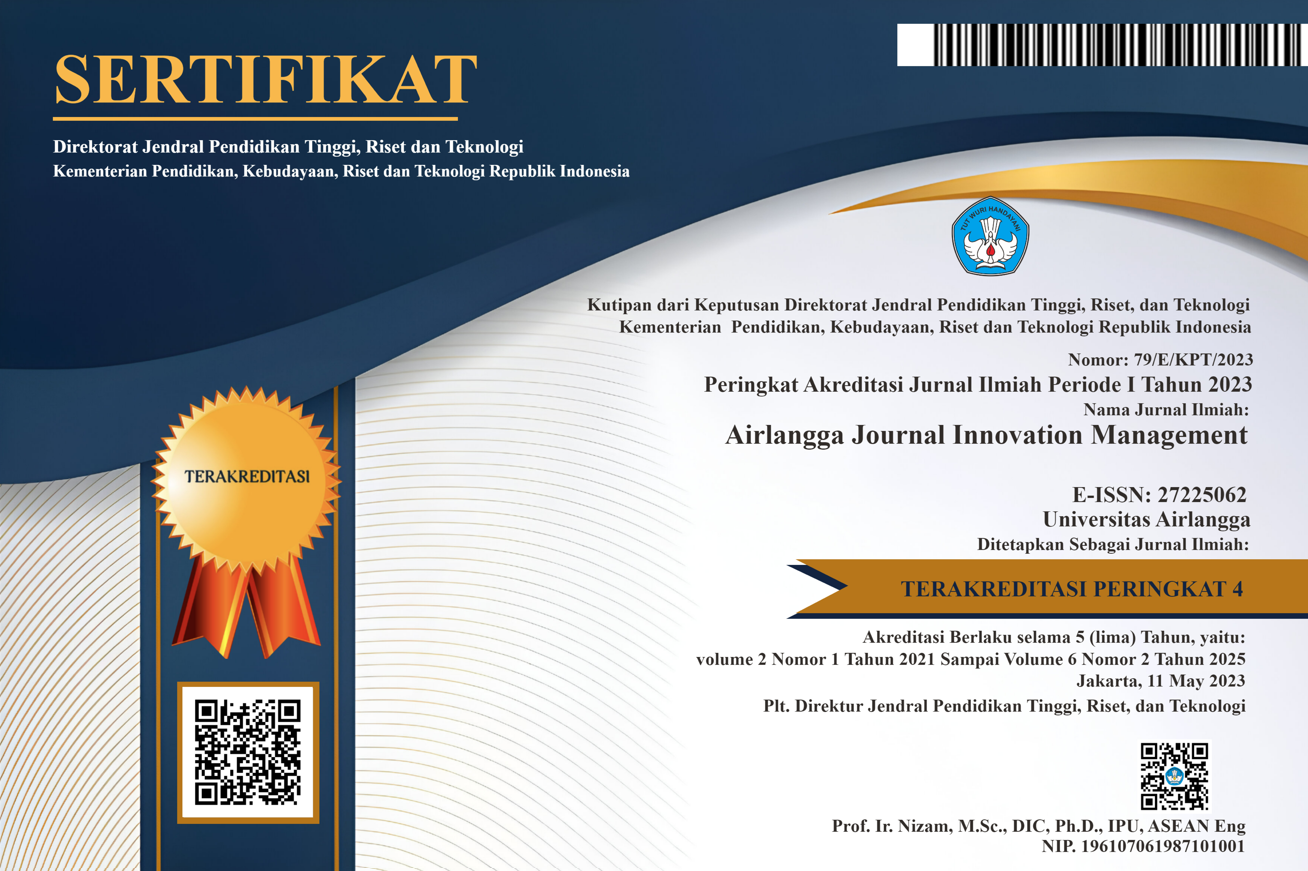THE EFFICIENCY OF BAITUL MAL WA TAMWIL (BMT) IN SURABAYA USING DATA ENVELOPMENT ANALYSIS (DEA)
Downloads
This study aims to find out whether Islamic microfinance, especially in Baitul Maal wat Tamwil in Surabaya has reached the level of efficiency in its operational activities from or not. This research uses a quantitative approach within Data Envelopment Analysis (DEA) technique. This study uses primary data which directly retrieves Islamic microfinance financial report data from Islamic microfinance. The results showed that the efficiency value of Variable Returns to Scale (VRS) processing was higher than the Constant Returns to Scale (CRS) processing result. From five BMT that become research objects of this study, just one institution that pass efficiency level and able to optimally use its resources (inputs) to produce certain outputs. On the assumption of CRS and VRS, most of Islamic Microfinance in Surabaya has not been efficient from 2012-2017 and Islamic microfinance in Surabaya is on the scale of diseconomies, that is Islamic Microfinance in Surabaya not yet optimally in empowering its resource (input) to produce output. So that Islamic microfinance in Surabaya must make improvements in managing inputs in order to improve efficiency value by doing selective funding to avoid default payment and the increase of uncollectible accounts expense. Each BMT has a different efficiency level that need to improved by treatment, including reduce operational expenses, reduce assets, and increase income. The implication of this study is an improvement strategies for each BMT to get their efficiency level betterment.
Alamsyah, I. E. (2015). Aset BMT Indonesia Capai Rp 4,7 Triliun _ Republika Online.
Amalia, Z. R. (2013). Perbandingan tingkat efisiensi bank umum konvensional (buk) dengan bank umum syariah (bus) menggunakan metode data envelopment analysis (dea). Kategori Peneliti Muda, 1–20.
Apriadi, F., & Alexandi, M. F. (2013). Solusi Peningkatan Sumberdaya Manusia Pada Baytul Maal wat Tamwil ( BMT ) di Indonesia Melalui Pendekatan Analytic Network Process ( ANP ) The Solution of Human Resources Development for Baytul Maal wat Tamwil ( BMT ) in Indonesia : an Analytic Network Pr. Al-Muzara'ah, 1(2), 107–118.
Ascarya, & Yumanita, D. (2006). Analisis Efisiensi Perbankan Di Indonesia Dengan Pendekatan Data Envelopment Analysis (DEA). TAZKIA Islamic Finance and Business Review, 1(2), 1–32.
Assauri, Sofyan. 2000. Manajemen Produksi dan Operasi. Jakarta : Lembaga Penerbit FE UI
Charnes, A., Cooper, W. W., & Rhodes, E. (1978). Measuring the efficiency of decision making units. European journal of operational research, 2(6), 429-444.
Coelli, T. J., Prasada Rao, D. S., O'Donnell, C. J., & Battese, G. E. (2005). An introduction to efficiency and productivity analysis. In An Introduction to Efficiency and Productivity Analysis. https://doi.org/10.1007/b136381
Dumilah, Ratna, dkk. 2017. Analisis Efisiensi Biaya dengan Pendekatan Stochastic Frontier Approach (SFA) : Survey pada Koperasi Baitul Maal Wat Tamwil Kota Tangerang Selatan Periode 2011-2015.
Gunawan, F. A., & Utiyati, S. (2013). Analisis Tingkat Efisiensi Bank Bumn Dengan Pendekatan Data Envelopment Analysis ( Dea ). Ilmu Dan Riset Manajemen, 2(8), 1–17.
Hadad, dkk. 2003. Analisis Efisiensi Industri Perbankan Indonesia : Penggunaan Metode Nonparametrik Data Envelopment Analysis (DEA).
Hanafi, Mamduh M. dan Abdul Hanafi. 2008. Analisis Laporan Keuangan. Yogyakarta : UPP STIM YKPN
Hardoko, E. (2015). Akibat Kredit Macet, Lembaga Keuangan Syariah di Kabupaten Semarang Bangkrut. In Kompas.com (p. 1). https://regional.kompas.com/read/2015/02/15/01564431/Akibat.Kredit.Macet.Lembaga.Keuangan.Syariah.di.Kabupaten.Semarang.Bangkrut
Jaiyeoba, Haruna Babatunde, dkk. 2017. Measuring Efficiencies of Bangladesh and Indonesian Microfinance Institutions :5 A Data Envelopment Analysis and Latent Growth Curve Modelling Approach.
Kurniawan, D. (2014). 3 Sektor Ini Jadi Penunjang Utama Perekonomian Surabaya. In Liputan 6 (p. 1). https://www.liputan6.com/bisnis/read/2098597/3-sektor-ini-jadi-penunjang-utama-perekonomian-surabaya?related=dable&utm_expid=.9Z4i5ypGQeGiS7w9arwTvQ.1&utm_referrer=https%3A%2F%2Fwww.google.com%2F
Mahbubi Ali Ketua KSEI PROGRES, M., & Efisiensi Baitul Maal Wat, A. (2010). Analisis Efisiensi Baitul Maal Wat Tamwil Dengan Pendekatan Two Stage Data Envelopment Analysis (Studi Kasus Kantor Cabang BMT MMU Dan BMT UGT Sidogiri). Agustus– Desember TAZKIA Islamic Finance & Business Review M. Mahbubi Ali Ascarya TAZKIA Islamic Finance & Business Review, 5(52), 110–125.
Muharam, H., & Pusvitasari, R. (2007). Analisis Perbandingan Efisiensi Bank Syariah di Indonesia Dengan Metode Data Envelopment Analysis (periode Tahun 2005). Jurnal Ekonomi Dan Bisnis Islam, II(3), 80–116.
Muhibah, I. (2016). Journal of Economics and Business Aseanomics ( JEBA ) EFISIENSI BAITUL MAAL WATTAMWIL KOTA TASIKMALAYA PERIODE 2011-2015 PENDEKATAN STOCHASTIC FRONTIER ANALYSIS ( SFA ) DERIVASI FUNGSI PROFIT DAN BOPO. 1(1).
Soemitra, Andri. 2015. Bank dan Lembaga Keuangan Syariah. Jakarta : Kencana
Sutawijaya, A., & Lestari, E. P. (2009). Efisiensi Teknik Perbankan Indonesia Pascakrisis Ekonomi: Sebuah Studi Empiris Penerapan Model Dea. Jurnal Ekonomi Pembangunan: Kajian Masalah Ekonomi Dan Pembangunan, 10(1), 49. https://doi.org/10.23917/jep.v10i1.808
Widiarto, I., & Emrouznejad, A. (2015). Social and financial efficiency of Islamic microfinance institutions: A Data Envelopment Analysis application. Socio-Economic Planning Sciences, 50, 1–17. https://doi.org/10.1016/j.seps.2014.12.001
Wulansari, Retno. 2010. Efisiensi Relatif Operasional Puskemas-Puskemas di Kota Semarang Tahun 2009.
Yakub, Edy M. (2014). Gubernur BI Jadikan Surabaya Pusat Ekonomi Syariah _ Antara News.
Zaenal Abidin, & Endri Endri. (2009). Kinerja Efisiensi Teknis Bank Pembangunan Daerah: Pendekatan Data Envelopment Analysis (DEA). Jurnal Akuntansi Dan Keuangan, 11(1), 21–29. http://puslit2.petra.ac.id/ejournal/index.php/aku/article/view/17863

This work is licensed under a Creative Commons Attribution-NonCommercial-ShareAlike 4.0 International License.
- The journal allows authors to hold copyright without restrictions and retain publication rights without restrictions. The author retains the copyright and grants the first publication rights to the journal, with his work simultaneously licensed under the Creative Commons Attribution-NonCommercial-ShareAlike 4.0 International License (CC BY-NC-SA). This license allows others to share the work with acknowledgment of authorship and initial publication in this journal, provided that the work is not used for commercial purposes and that any derivative works must use the same license.
- Authors may enter into additional contractual agreements for non-exclusive distribution of the journal publication version (e.g., uploading it to an institutional repository or publishing it in book form), while still including acknowledgment of the initial publication in this journal.
- Authors are allowed and encouraged to upload their work online (e.g., in an institutional repository or personal website) before and during the submission process. This can support productive scientific exchanges as well as increase citations to published works.

AJIM by UNAIR is licensed under a Creative Commons Attribution-NonCommercial-ShareAlike 4.0 International License.





















